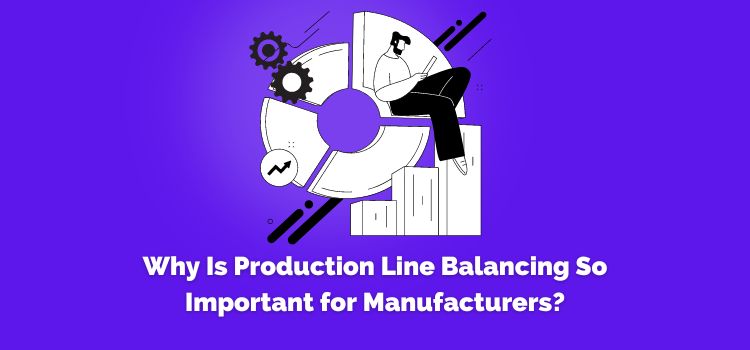Manufacturing is an incredibly complex process, requiring careful organization and precision to ensure that products come out of the production line according to plan. One way to achieve this is through production line balancing – a process that seeks to optimize a production line by ensuring every step within it can run as efficiently as possible.

This ensures that manufacturers can meet customer demand quickly and accurately, often leading to increased scalability and profitability.
In this blog post, we will explore why production line balancing is so important for manufacturers, what benefits it provides, common challenges associated with it, and some tips on how to go about achieving balance in your production lines.
By the end of this blog post, you should have gained a thorough understanding of the importance of maintaining balanced production lines in manufacturing and have identified some valuable strategies for achieving it.
So, let’s get started!
What Is Production Line Balancing?
Production line balancing is essential for any manufacturer to understand, as it can significantly impact productivity and profitability.
In simple terms, line balancing ensures that the operators’ and machines’ resources are used efficiently to meet the required production rate. Line balancing requires careful planning and analysis so that all tasks on the production line are completed at a rate that matches the takt time.
This means taking into account factors such as seasonal fluctuations, customer demand, changes in technology, skill levels of operators, and machine availability, amongst others.
By having a well-balanced production line, manufacturers can reduce costs associated with delays or overproduction while ensuring higher product quality.
Benefits of Production Line Balancing for Manufacturers
Production line balancing has several benefits for manufacturers, some of which include the following:
➤ Increased Productivity
Balancing a production line can increase the overall productivity of a manufacturing process. It involves strategically rearranging tasks to minimize wasted time and energy while maximizing output.
Manufacturers can make production lines more efficient by identifying bottlenecks in processes, adjusting the number of operators assigned to each task, or decreasing workloads on machines where possible.
This results in an increased throughput rate and greater output with fewer resources. Additionally, production line balancing allows manufacturers to optimize their operations by reducing downtime due to equipment breakdowns or operator fatigue and eliminating unnecessary costs associated with overstaffing or wasting materials.
Manufacturers can increase productivity and keep costs down by optimizing their operations through production line balancing.
➤ Reduced Production Costs and Increased Profit
Production line balancing is essential for manufacturers to reduce production costs and increase their profits. By optimizing production processes, manufacturers can ensure that the most efficient resources are being used and minimize the time spent waiting for materials or equipment.
When the production line is balanced, each step of the process is synchronized with one another to create a fluid workflow. Additionally, improved efficiency leads to reduced labor costs and decreased energy consumption – translating into increased profitability over time.
Production line balancing thus provides manufacturers with significant financial benefits by streamlining their operations and maximizing efficiency.
➤ Streamlined Workflow Processes
Production line balancing is essential in ensuring that the production process is as efficient and effective as possible. Optimizing workflow processes allows tasks to be assigned in an organized way, maximizing efficiency and minimizing waste.
This results in fewer errors due to human fatigue because all team members will have a more equitable distribution of tasks.
Furthermore, this optimization improves resource allocation, allowing manufacturers to track performance levels much more accurately throughout the entire manufacturing process.
Finally, production line balancing can provide numerous significant benefits to businesses in terms of streamlining and improving operations.
➤ Enhanced Employee Satisfaction
Production Line Balancing is beneficial for employee satisfaction because it creates an efficient work environment in which individuals can complete tasks quickly and efficiently. This helps develop a sense of accomplishment, as employees can see the tangible results of their hard work.
Additionally, when production lines are appropriately balanced, workers have less idle time, which leads to increased productivity and morale.
As employees feel appreciated and secure with their job roles, they tend to take ownership of the task (quality control or assembly line operations). This improves employee engagement and makes them feel valued by their company.
How To Achieve Perfect Production Line Balancing
Perfect production line balancing necessitates meticulous planning and execution to guarantee that each station operates at its maximum capability. Identifying system bottlenecks and making the necessary adjustments is the first step in achieving a balanced production line.
Once this has been accomplished, it is necessary to establish an ideal cycle time for each station to determine how long products should take to move through them during production.
In order to reduce setup times and enhance production rates, manufacturers could also consider modifying the process or equipment utilized at each station.
Lastly, manufacturers must keep track of their production line balancing efforts since constant monitoring and development can assist in optimizing the system further; using line balancing software like LineView helps simplify this process.
By using these measures, manufacturers can ensure that their production lines are balanced and operating as effectively and efficiently as possible, benefiting the company’s bottom line.
Conclusion
Production line balancing is an essential part of the manufacturing process that helps manufacturers achieve greater efficiency and cost savings. By maximizing production throughput, streamlining workflow, and reducing bottlenecks, manufacturers can ensure the timely delivery of products to customers.
The importance of production line balancing cannot be overstated; it is a critical factor in determining the success or failure of any organization’s operations in today’s competitive market.
With proper implementation, including the use of reliable equipment like simple motors, organizations can benefit from increased productivity, improved quality control standards, and decreased downtime–all while increasing their bottom line.
Investing in production line balancing will help create a more effective and efficient facility that can stand up to the competition in today’s world.